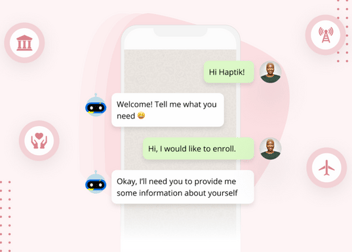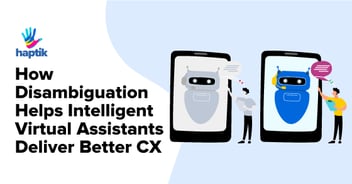“For X, Dial 1. For Y, Dial 2”.
We’re all familiar with some variation of these words, told to us by an automated voice on the phone.
At the most basic level, Interactive Voice Response or IVR can be defined as an automated telephony system that interacts with callers through the use of voice and DTMF (dual-tone multi-frequency) keypad ‘touch tones’.
A typical IVR scenario involves a customer initiating a phone call with a company and being greeted by the IVR system. The IVR gives the customer prompts to navigate through what is essentially a telephonic ‘menu’. Through the caller’s inputs, the system is able to segment them on the basis of intent and route them to the appropriate customer service agent.
IVR systems have long been a key technology for call centres for the following reasons:
-
Increased efficiency: By segmenting callers and guiding them to the appropriate department/agent, IVR boosts the overall efficiency of a call center, since it ensures that the caller is connected with an agent who is best-equipped to provide a swift resolution to their query.
-
Reduced costs: An IVR system effectively replaces the ‘receptionist’ who would otherwise be needed to field customer calls and route them to relevant agents. More sophisticated IVR systems function as self-service tools, significantly reducing a business’ overall dependency on human agents, and thus bringing down operational costs.
-
Improved customer experience: IVR ensures that a customer’s call is always routed to the appropriate agent who can resolve their specific query, or helps them seamlessly resolve their own query. This significantly improves their experience, and helps avoid the frustration caused by frequent transfer of calls and/or inept handling of a query by an inappropriate agent.
Explore 7 remarkable Conversational IVR trends for the year 2021 and beyond
Issues with Traditional IVR
While IVR systems have gone a long way towards improving efficiency in the call centre, traditional IVR systems have a number of drawbacks, such as:
Redundant technology
Traditional IVR relies on old and stale technologies. This makes it difficult for businesses to scale up their IVR systems for increased usage. Moreover, as traditional IVR systems lack any Natural Language Processing (NLP) capabilities, they cannot take into account any errors that customers might make while verbally selecting options – for instance, mispronouncing a phrase. They also cannot account for the customers using synonyms or even speaking in a heavy or distinct accent!
Limited and cumbersome navigation
Traditional IVR systems give customers a limited menu of options. These options may or may not encompass a customer’s specific requirements, and might lead to them selecting an option that proves to be unsuitable, potentially resulting in a frustrating and negative experience. Even if the options provided match the customer’s requirement, they still need to go through the tedious process of navigating a complex ‘menu tree’.
Long wait times
Traditional IVR is ultimately reliant on human agents to handle more complex queries. As a result, customers are often forced into fairly long waits during a call before the agent becomes available. The complex routing system means that the customer’s call can be transferred to multiple departments before they get to speak to an agent who can resolve their issue – which adds to the poor customer experience, and contributes to high IVR abandonment rates.
IVR Automation Through Conversational AI
Conversational IVR (i.e. the use of Conversational AI to automate IVR) is the latest innovation in IVR. The benefits of traditional IVR are augmented by the power of Natural Language Understanding (NLU) and Machine Learning, coupled with advanced voice recognition technology.
Conversational AI expands the scope of IVR from being a mere ‘telephonic menu’ system, allowing for greater flexibility and interactivity – thus significantly enhancing customer experience.
Here are some of the ways in which Conversational IVR improves upon Traditional IVR:
Offers greater flexibility
As we’ve already discussed, traditional IVR systems present users with a limited menu of options, that may or may not serve their purpose, and forces them through a cumbersome navigation process.

Conversational IVR, on the other hand, allows a customer to speak in free form, stating their requirements in the words of their choice. The system can intelligently pick up relevant keywords and phrases, gain a clear insight into the customer’s intent, and seamlessly provide a resolution.
Becomes ‘smarter’ over time
As it handles more customer queries, a Conversational IVR solution learns over time, enhancing its capability to handle a greater variety of tasks and/or resolve more query types.

Conversational IVR becomes smarter over time, learning from interventions made by human agents
For instance, if the IVR is unable to deal with a particular query, a live agent can intervene and manually guide the system to a resolution. The next time the system encounters a similar situation, it will be able to resolve the issue with minimal or no intervention, based on the data gathered from the previous instance.
More cost-effective
Traditional IVR is expensive – taking into account infrastructure and maintenance costs, agent training and remuneration etc. This is in fact one of the key factors that makes it difficult to scale, in addition to the outdated technology. In fact, assuming a 10% monthly increase in users, enterprises using traditional IVR systems could be looking at an annual call center cost increase of 185%!
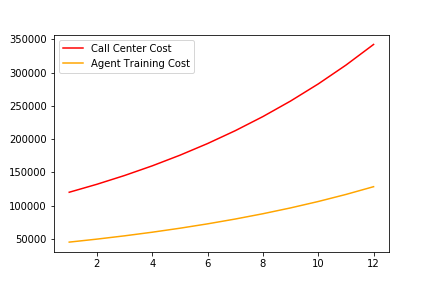
The costs of scaling Traditional IVR are exorbitant – a problem that can be overcome with Conversational IVR
On the other hand, the cost per call with Conversational IVR could be as low as one-eighth the cost of a traditional voice interaction.
When it comes to customer care, recruitment and staffing has one been one of the most significant costs for enterprises. While traditional IVR reduced those costs to an extent, automating IVR through Conversational AI can lead to a far more substantial cost saving by reducing dependency on human agents to an even greater degree. In addition to helping enterprises cut down on the number of agents, Conversational IVR also reduces the Average Handle Time, thus maximizing agent productivity and further reducing costs.
Improves customer experience
Great customer service is one of the most effective ways to earn lasting customer trust and loyalty. A Conversational IVR solution can be a powerful asset for enterprises in this regard.
With the widespread adoption of smart speakers and voice-based virtual assistants such as Alexa, Siri, Google Now etc. customers have gradually become accustomed to engaging with voice-based Conversational AI. So offering them an interactive self-service option that enables them to get quick, accurate responses to their queries and/or swift resolution of their service issues is a great way to boost their engagement with the business.
Conversational IVR frees the customer from traditional IVR irritants such as repeatedly having to push buttons, listen to the system tediously reciting menu options, being routed to the wrong department and dealing with an agent not suited to resolving their query etc. That alone substantially contributes to creating a positive customer experience.
RELATED: How Conversational AI Automates & Streamlines Customer Interactions
Use Cases for Conversational IVR
Conversational IVR can be effectively implemented across a number of industries and verticals for two broad use cases – customer inquiry response and customer issue resolution.
Travel & Hospitality
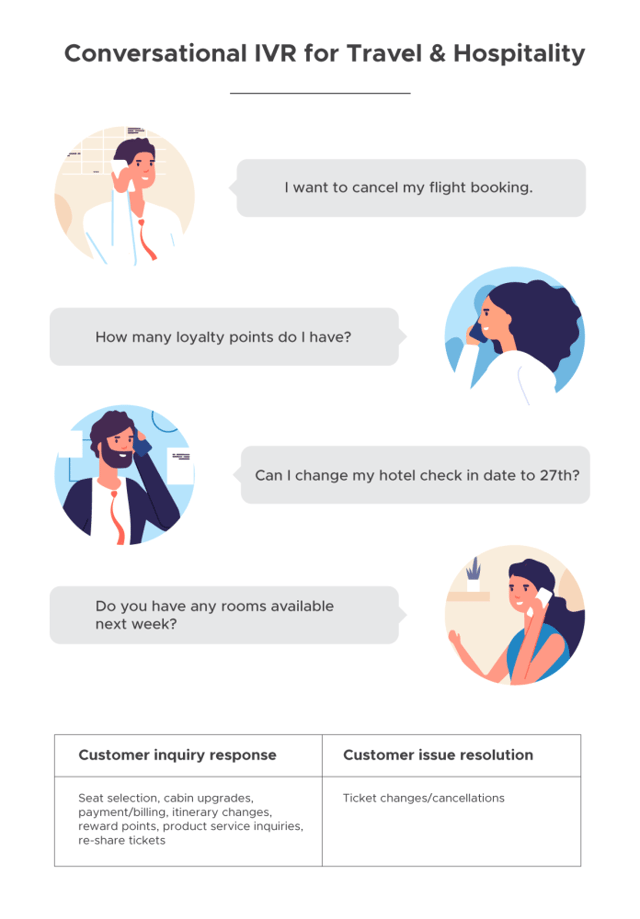
E-Commerce & Retail
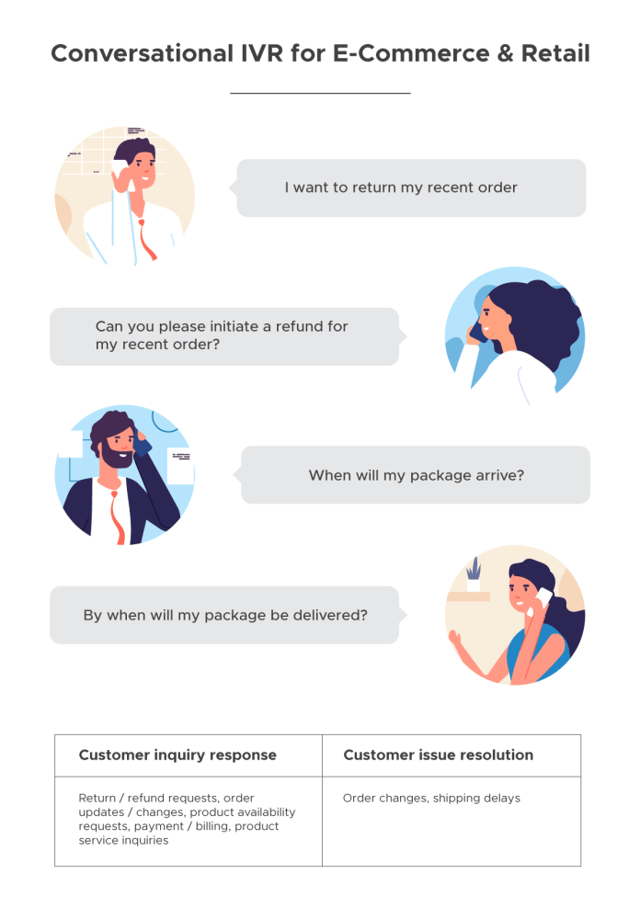
Financial Services

Why Enterprises Should Adopt Conversational IVR
You should implement a Conversational IVR solution for your business if:
-
Your call centres are fielding large volumes of calls (in the thousands, or even hundreds of thousands) – 70-80% of which are repetitive in nature. Automating the response to such calls significantly reduces call centre traffic, leading to substantial cost savings. Even a 10-20 second reduction in time per call can compound into significant savings over time for a larger enterprise, delivering a high ROI.
-
Your business is experiencing high IVR abandonment rates due to customer frustration with the tedious navigation and complex routing mechanism of your legacy IVR system.
-
Your customer service agents are unable to always provide timely and accurate responses to customer queries, or maintain the overall desired quality of customer care in your organization.
To sum up…
The future is increasingly looking to be a voice-first one, and customer care is no exception to that trend. In a world where smart speakers and voice-based virtual assistants are ceasing to be a novelty and simply becoming a fact of life, it is incumbent upon enterprises to offer their customers an effective and engaging voice-based interface. Conversational IVR is an emerging technology which is certainly poised to potentially be the bulwark of customer care in the years to come.









